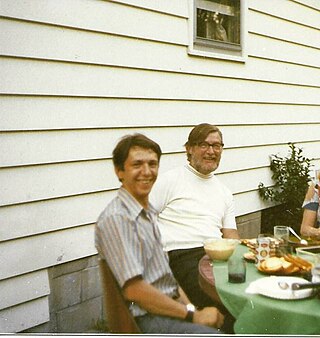Related Research Articles
Quadratic programming (QP) is the process of solving certain mathematical optimization problems involving quadratic functions. Specifically, one seeks to optimize a multivariate quadratic function subject to linear constraints on the variables. Quadratic programming is a type of nonlinear programming.

Linear programming (LP), also called linear optimization, is a method to achieve the best outcome in a mathematical model whose requirements are represented by linear relationships. Linear programming is a special case of mathematical programming.

Mathematical optimization or mathematical programming is the selection of a best element, with regard to some criterion, from some set of available alternatives. It is generally divided into two subfields: discrete optimization and continuous optimization. Optimization problems arise in all quantitative disciplines from computer science and engineering to operations research and economics, and the development of solution methods has been of interest in mathematics for centuries.
In mathematics, nonlinear programming (NLP) is the process of solving an optimization problem where some of the constraints or the objective function are nonlinear. An optimization problem is one of calculation of the extrema of an objective function over a set of unknown real variables and conditional to the satisfaction of a system of equalities and inequalities, collectively termed constraints. It is the sub-field of mathematical optimization that deals with problems that are not linear.
In mathematical optimization theory, the linear complementarity problem (LCP) arises frequently in computational mechanics and encompasses the well-known quadratic programming as a special case. It was proposed by Cottle and Dantzig in 1968.
Convex optimization is a subfield of mathematical optimization that studies the problem of minimizing convex functions over convex sets. Many classes of convex optimization problems admit polynomial-time algorithms, whereas mathematical optimization is in general NP-hard.
The Frank–Wolfe algorithm is an iterative first-order optimization algorithm for constrained convex optimization. Also known as the conditional gradient method, reduced gradient algorithm and the convex combination algorithm, the method was originally proposed by Marguerite Frank and Philip Wolfe in 1956. In each iteration, the Frank–Wolfe algorithm considers a linear approximation of the objective function, and moves towards a minimizer of this linear function.
A second-order cone program (SOCP) is a convex optimization problem of the form
The TOMLAB Optimization Environment is a modeling platform for solving applied optimization problems in MATLAB.
In mathematical optimization, a quadratically constrained quadratic program (QCQP) is an optimization problem in which both the objective function and the constraints are quadratic functions. It has the form
In computer programming, a scientific programming language can refer to two degrees of the same concept.

In mathematical optimization, the criss-cross algorithm is any of a family of algorithms for linear programming. Variants of the criss-cross algorithm also solve more general problems with linear inequality constraints and nonlinear objective functions; there are criss-cross algorithms for linear-fractional programming problems, quadratic-programming problems, and linear complementarity problems.
Philip Starr "Phil" Wolfe was an American mathematician and one of the founders of convex optimization theory and mathematical programming.
Artelys Knitro is a commercial software package for solving large scale nonlinear mathematical optimization problems.

Carlton Edward Lemke was an American mathematician.
The quadratic knapsack problem (QKP), first introduced in 19th century, is an extension of knapsack problem that allows for quadratic terms in the objective function: Given a set of items, each with a weight, a value, and an extra profit that can be earned if two items are selected, determine the number of items to include in a collection without exceeding capacity of the knapsack, so as to maximize the overall profit. Usually, quadratic knapsack problems come with a restriction on the number of copies of each kind of item: either 0, or 1. This special type of QKP forms the 0-1 quadratic knapsack problem, which was first discussed by Gallo et al. The 0-1 quadratic knapsack problem is a variation of knapsack problems, combining the features of unbounded knapsack problem, 0-1 knapsack problem and quadratic knapsack problem.

Richard W. Cottle is an American mathematician. He was a professor of Management Science and Engineering at Stanford University, starting as an Acting Assistant Professor of Industrial Engineering in 1966 and retiring in 2005. He is notable for his work on mathematical programming/optimization, “Nonlinear programs”, the proposal of the linear complementarity problem, and the general field of operations research.
James Milton Renegar Jr. is an American mathematician, specializing in optimization algorithms for linear programming and nonlinear programming.
References
- 1 2 Albert-Goldberg, Nancy (2005). A3 & His Algebra: How a Boy from Chicago's West Side Became a Force in American Mathematics. iUniverse. p. 348. ISBN 9781469726397.
- 1 2 "Marguerite Josephine Straus Frank". Mathematics Genealogy Project. Retrieved 2017-03-06.
- ↑ Assad, Arjang A; Gass, Saul I (2011). Profiles in operations research: pioneers and innovators. Boston, MA: Springer Science+Business Media. ISBN 9781441962812.
- ↑ Frank, M.; Wolfe, P. (1956). "An algorithm for quadratic programming". Naval Research Logistics Quarterly. 3 (1–2): 95–110. doi:10.1002/nav.3800030109.
- ↑ "Joseph Frank, Biographer of Dostoevsky, Dies at 94". New York Times . 4 March 2013. Retrieved 13 March 2014.